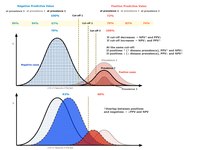
Photo from wikipedia
ABSTRACT Purpose: The purpose of this study is to explore the diagnostic accuracy and clinical utility of an examination by a physical therapist using a clinical patient population for diagnosing… Click to show full abstract
ABSTRACT Purpose: The purpose of this study is to explore the diagnostic accuracy and clinical utility of an examination by a physical therapist using a clinical patient population for diagnosing a specific sub-type of disc displacement (DDWoR wLO) compared to the imaged disc position. Methods: Data from 46 patients with a clinical diagnosis of DDWoR wLO (92 clinical examinations and MRI records) were collected. Clinical diagnosis was made based on predefined diagnostic criteria, and the MRI diagnosis was made based on the MRI radiology report obtained from the dental provider. A McNemar test was used to determine whether the outcomes of the clinical and MRI diagnoses differed significantly, and sensitivity, specificity, likelihood ratios, predicative values, 95% confidence intervals, and the overall diagnostic accuracy were computed. Results: There was high sensitivity (85%), moderate but unacceptable specificity (73%), and acceptable overall diagnostic accuracy (80%) for using predefined criteria in the diagnosis of DDWoR wLO. The likelihood ratios and predictive values supported the clinical utility of the criteria used for diagnosing DDWoR wLO. Conclusion: This is the first study to characterize diagnostic accuracy by a physical therapist of a specific sub-type of TMD in a clinical patient population rather than a research based population. The results suggest that while sensitivity and the overall diagnostic accuracy were acceptable, specificity was lower than acceptable and these findings are discussed in relation to clinical utility of using diagnostic criteria in a clinical setting against a gold standard of MRI.
Journal Title: Physiotherapy Theory and Practice
Year Published: 2017
Link to full text (if available)
Share on Social Media: Sign Up to like & get
recommendations!